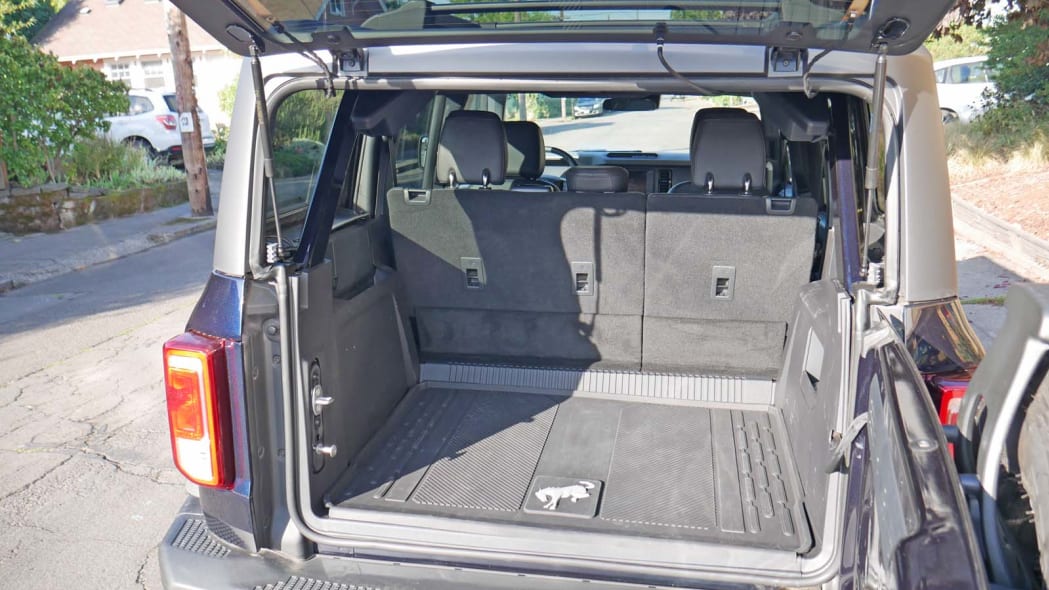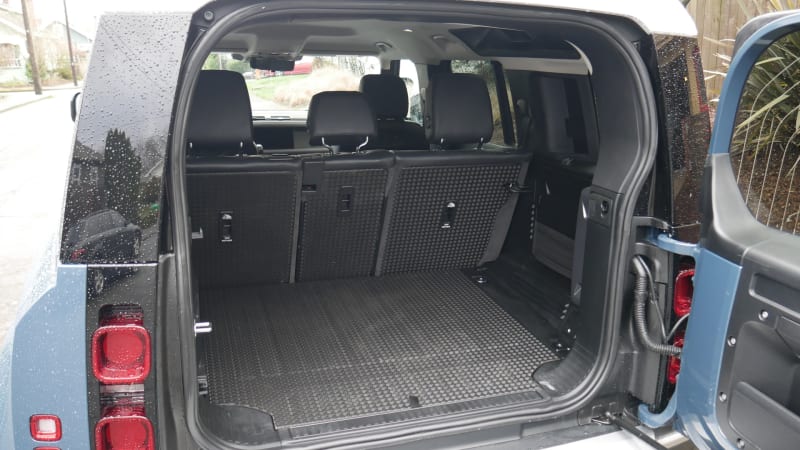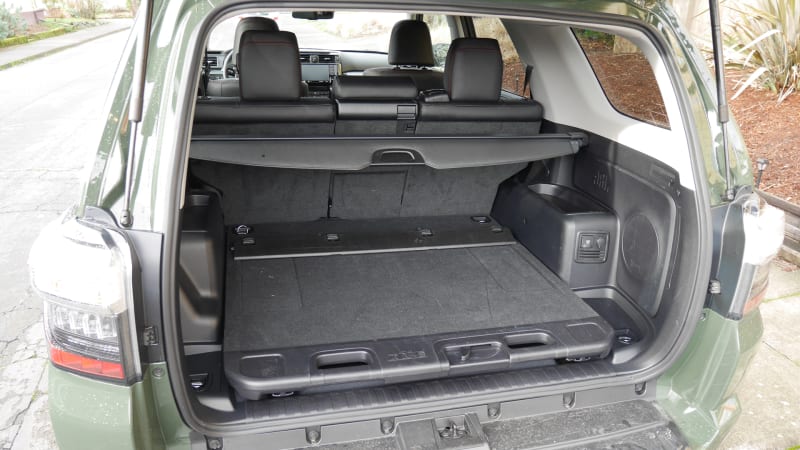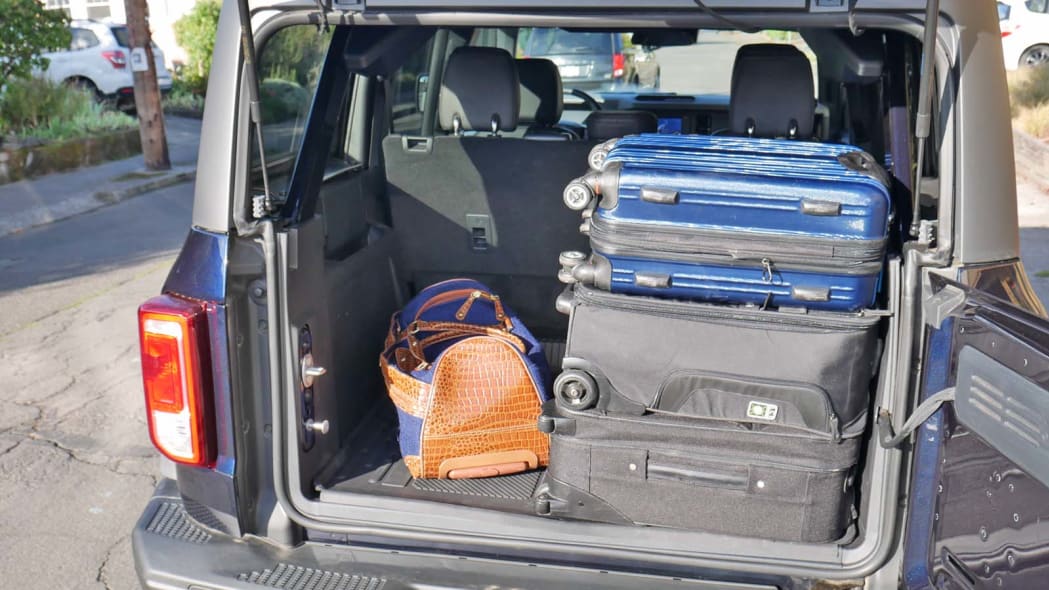The Ford Bronco 4-Door has 35.6 cubic-feet of cargo space behind its raised back seat when equipped with the hardtop. It goes up ever-so-slightly to 38.3 cubic-feet with the soft-top, and should you only want two doors (good for you!), the number falls down to 22.4 cubic-feet. That’s actually 10 cubes less than the Bronco Sport that I have previously luggage tested.
Now, how does the Bronco 4-Door’s cargo capacity compare to its primary competitors? Well, as luck would have it, I’ve luggage tested all those. The Jeep Wrangler Unlimited with its own hardtop has 31 cubic-feet behind the back seat (its two-door has only 13 cubes). The Land Rover Defender 110 lands at an even 34.0 (with a 15.6-cube figure for the two-door 90). Finally, the Toyota 4Runner is the king of the hill with 47.2 cubes, though that does go down a bit with the roll-out cargo floor. There is no two-door 4Runner and in a dreadful lack of foresight, Toyota stopped selling the FJ Cruiser years ago.
OK, now that the numbers are out of the way, let’s see how much the Bronco can actually carry and how it compares to all those.

Here is the 4-Door’s cargo area. Like the Wrangler, you swing the gate open first (into the curb) and then open up the glass hatch. It will take a very long time before I remember this order when closing it all. As it is, I put the glass down first roughly 90% of the time. Not sure why, maybe it’s driving my mother’s CR-V in the late ’90s? That did gate first, then glass. I don’t know. I’m sure I’d get it eventually.
OK, now here are all the off-road SUV cargo holds in one place, clockwise from upper left: Bronco, Wrangler, 4Runner, Defender.




I don’t know about you, but it’s immediately obvious looking at all those that the Wrangler is at a disadvantage that’s perhaps greater than its on-paper-figures would indicate. Its diagonal structural support is further inboard than the Bronco’s, meaning more of its on-paper cargo capacity is on the outside of it, and therefore less useful.
OK, let’s get to the bags. As with every luggage test, I use two midsize roller suitcases that would need to be checked in at the airport (26 inches long, 16 wide, 11 deep), two roll-aboard suitcases that just barely fit in the overhead (24L x 15W x 10D), and one smaller roll-aboard that fits easily (23L x 15W x 10D). I also include my wife’s fancy overnight bag just to spruce things up a bit (21L x 12W x 12D).

Um, yeah, I basically only needed half the cargo area. There was so much room remaining, I didn’t even need to remove the massive collection of carrier bags included to keep the doors and various roof panels safe when you remove them. They even include a little diagram to show how you can Tetris them all in the cargo area. That’s a test for another day, certainly.


OK, here is the same luggage test set of bags in all of the above SUVs. Again, clockwise from upper left: Bronco, Wrangler, 4Runner, Defender.




First, keep in mind that the leftover space is not created equal. Both the Bronco and Wrangler need to leave a decent amount of space open near their swing gate latches. Basically, nothing can fit behind that gray bag in the lower left of the Wrangler.
OK, now let’s filler up.

For starters, the 38-quart cooler I normally use to fill the remainder barely scratched the surface.
Beyond that, this test does veer from apples-to-apples comparisons since I used different extra items. Oh well, you’ll get the idea.




Extra stuff the Bronco: 38-quart cooler, blue duffle bag, flat-folded kid-carrier back pack, and the two front roof panels. Ideally, you’d put them in the included bag, but I just wasn’t up for that. I’m not actually going somewhere.
Extra stuff in the Wrangler: Graco Pack ‘N Play box, blue duffle bag. Yeah, it loses.
Extra stuff in 4Runner: 38-quart cooler, box for Graco Pack ‘N Play, box for two-person inflated river raft, small backpack that’s the same size as that blue duffle bag. Yeah, it wins.
Extra stuff in Defender: 38-quart cooler, blue duffle bag, skinny briefcase, probably a grocery bag or two cause there’s obviously more roof left.
(Extra stuff in Bronco Sport in case you were wondering: Pack ‘N Play, skinny briefcase).
So there you have it, the luggage test rankings mirror the on-paper figures, but their differing cargo area shapes, body structures and door designs do make a difference.
Ok, now that the comparison are out of the way, let’s take a quick look at some other cargo-related Bronco features.


Below the rubber floor mat (part of the Black Diamond trim level) is a plastic floor that should be easily cleaned.

The sides of the cargo area are also plastic, which is good for cleaning, but it’s very cheap and very scratchy. It definitely won’t take long for this to look like a cat used it as a scratching post.

Like the Wrangler, there is some underfloor storage. One compartment is for the jack and a funnel, while the other can be used for whatever contraband you see fit.


Finally, this Bronco had the optional roof rails. They’re big, chunky, sturdy things, which according to Yakima’s fitment technician Taylor Thompson, makes them indeed better suited to hold heavier things like roof tents. He was quite impressed with Ford’s effort.
The trouble is, they do impede removing the roof panels. While I could finagle out each of the two front pieces (it would otherwise be SUPER easy to unlatch and lift them off), there was no way the large, single-piece back seat roof piece was coming off without removing the rails. That would require a tool and lots of extra effort, and yeah, I just wasn’t up for that. Again, another test for another time.

